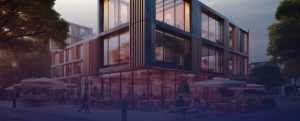How Office Campuses Are Evolving into Hybrid Workspaces
Office campuses have undergone a profound transformation in recent years, shaped by shifts in tenant preferences due to the pandemic, changes in urban development, and emerging trends in real estate investment. As remote and hybrid work models gained prominence, traditional office campuses faced rising vacancies, leading to an increased focus on integrating high-value amenities to attract tenants and boost occupancy. One standout evolution is the growing integration of restaurants and entertainment facilities within office campuses, which is helping landlords increase rents and enhance the appeal of office buildings. This shift underscores a significant trend: the transformation of vacant office space into amenity-rich hubs designed to draw a diverse range of users.
Amenity-Driven Developments
Amenities and green spaces serve as a strategic tool for not only landlords to attract tenants to office campus buildings, but also for businesses to encourage employees back into the office. It provides for an attractive feature for workers who are looking to socialize and a way for landlords to align with businesses’ goals to foster an in-person work culture. Amenity-driven spaces are a valuable asset in attracting and retaining tenants and workers alike. For example, at Galleria on the Park, a 2.1 million square foot office campus, developers have allocated a portion of their budget to create several restaurant spaces. This investment is expected to increase office rents and transform the campus into a vibrant destination for both office tenants and the general public. With occupancy rates at 93%, the office park is further enhancing its value by converting unused spaces into restaurants, amenities, hotels, and retail.
The shift toward integrating restaurants into office campuses is not limited to single locations. Simon Property Group, a giant retail landlord, has been investing heavily in mixed-use developments to revitalize its properties. At The Shops at Clearfork in Fort Worth, Texas, the company plans to add office space, retail, and entertainment facilities to its 556,000 square foot center, aiming to create an all-encompassing experience that boosts foot traffic. Similarly, Phipps Plaza in Atlanta has been reimaged with a Life Time fitness club, a Nobu hotel and restaurant, and a 13-story office building, reflecting commitment to diversifying tenant offerings to enhance the overall appeal of the property.
The Value Proposition of Restaurants in Office Campuses
Integrating restaurant spaces has become a strategic move for landlords as they look to add value beyond traditional workspaces. Restaurants within office campuses serve as both amenities for employees and attractions for the local community, helping to fill office vacancies and drive traffic to other on-site retailers. However, this approach requires substantial investment and long-term planning, as the high costs associated with restaurant buildouts may not yield direct profits for landlords for several years. In general, adding restaurant space takes up to eight years to break even, yet it is seen as a critical investment to increase rent premiums and overall appeal.
Operational challenges also accompany the integration of restaurants. Parking constraints can pose issues, especially in urban areas where space is limited. To address this, many office campuses, particularly older buildings with surplus parking, have introduced valet services. However, parking is not typically an issue after 5 p.m. as office workers leave for the day. Additionally, the hours of operation are often extended beyond typical office hours, with destination restaurants offering brunch, lunch, and dinner, catering to both office workers and external visitors. With the additional hours, restaurants must find creative ways to offer more parking.
Regional Shifts & Tenant Preferences
In some areas, office occupancy rates have rebounded, driven by an increasing demand for smaller, amenity-rich spaces. Orange County, California, has bucked the trend of declining occupancy rates, seeing a steady expansion of tenant occupancy. Notably, Orange County office tenants expanded by nearly 650,000 square feet in the second quarter of 2024 and an additional 100,000 square feet in the third quarter. Smaller office suites have been especially popular, with over 2,000 leases signed for spaces under 5,000 square feet, accounting for 42% of leasing activity. This stands in contrast to larger office markets like Los Angeles and San Francisco, where tenant occupancy declined by 5 million and nearly 2% of inventory, respectively, over the trailing year.

The Rise of Mixed-Use & High-End Office Properties
In response to tenant demand, high-end office campus properties with premium amenities have seen a surge in popularity, attracting tenants who are willing to pay a premium for quality spaces. The office market in Washington, D.C., illustrates this shift, with only 20 Class A office campus properties having space available over 50,000 square feet, primarily concentrated downtown. These high-end properties offer features such as LEED certification, Energy Star ratings, and state-of-the-art configurations and command average rents of $68 per square foot, significantly higher than mid-range properties.
In Northern Virginia and Suburban Maryland, similar trends are observed. Class A buildings located in areas like Tysons, the Rosslyn-Ballston Corridor, and Bethesda have limited availability for larger spaces but attract premium rents due to their high-quality amenities and convenient locations. Meanwhile, buildings with smaller, less desirable spaces are struggling to find tenants.

The Return of Institutional Capital
The demand for Class A, amenity-rich office spaces has encouraged institutional investors to re-enter the office market after a period of caution. Highwoods Properties, for instance, is actively seeking high-quality office assets to expand its portfolio across Sunbelt markets, such as Nashville, Orlando, Atlanta, and Raleigh, where demand has remained strong. The company’s year-to-date leasing volume reached over 1.3 million square feet, driven by a flight-to-quality trend that reflects a growing interest in Class A properties with unique amenities.
This demand has bolstered leasing activity, with Cousins Properties reporting quarterly leasing volume at its highest level since 2019. The company’s portfolio, spanning major cities like Atlanta, Dallas, Houston, and Phoenix, has benefitted from rising tenant commitments and long-term leases, indicating a steady return to office spaces. Cousins has signed over 763,000 square feet in new and expanded deals through the third quarter, helping drive its occupancy rate above 91%.
The Path Forward: A Hybrid Future With Flexibility & Amenities
The evolution of office spaces from traditional workplaces to multi-functional hubs with restaurants, fitness centers, and entertainment options marks a new chapter in commercial real estate. As landlords and investors continue to adapt to changing tenant expectations, the demand for flexible, smaller spaces with top-tier amenities is likely to persist. Office-to-residential conversions are also gaining momentum, with over 100 such projects underway in major cities as of late 2023, providing a sustainable solution to the oversupply of office space in certain markets.
By investing in high-quality, mixed-use developments, landlords are creating dynamic office environments that cater to a diverse range of tenants and visitors. This trend points to a hybrid future where office campuses serve as both workspaces and lifestyle destinations, fulfilling the evolving needs of the workforce while maximizing the value of real estate assets.










